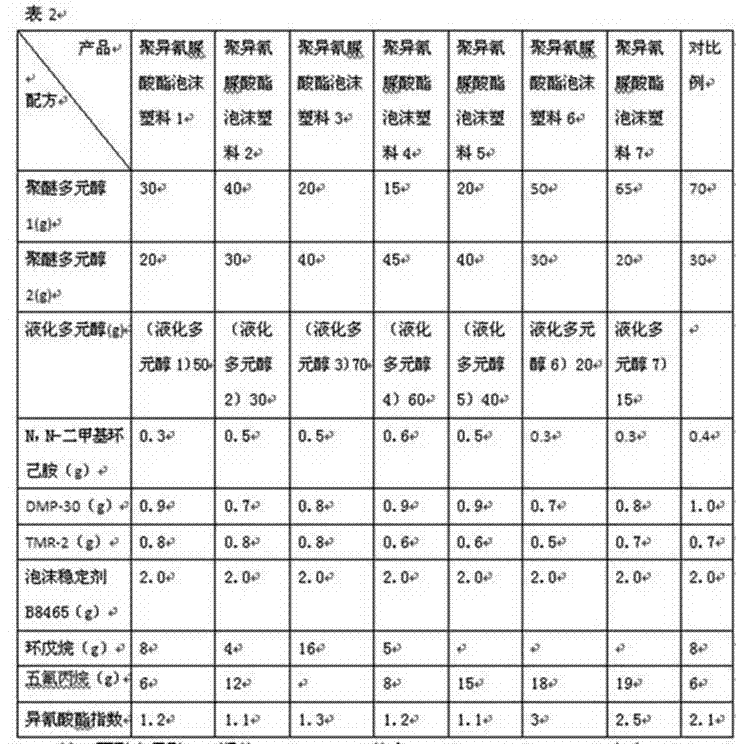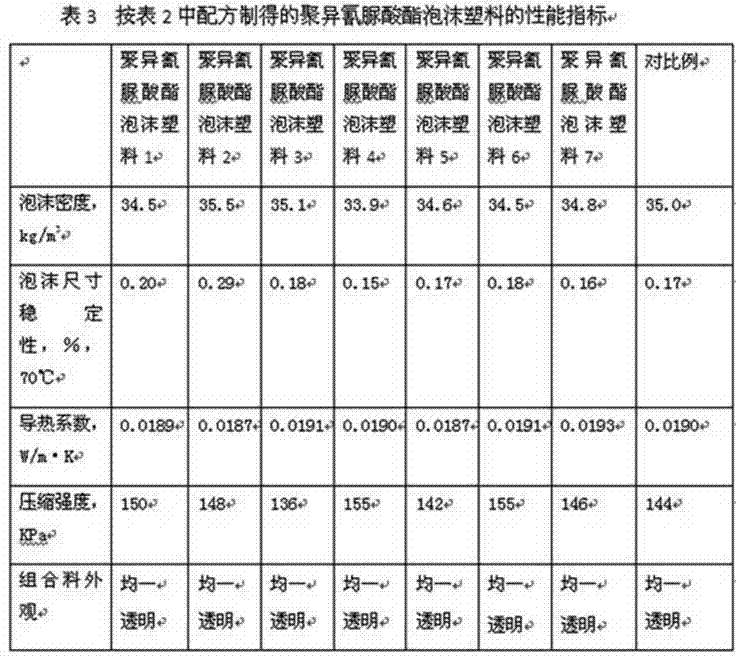Method for liquefying waste polyisocyanurate foamed plastics and liquefied polyol prepared from waste polyisocyanurate foamed plastics
A technology of polyisocyanurate and foamed plastics is applied in the field of liquefied polyols, which can solve the problems of low ring-opening efficiency and achieve the effects of uniform material system, good formability and good liquefaction effect.
- Summary
- Abstract
- Description
- Claims
- Application Information
AI Technical Summary
Problems solved by technology
Method used
Image
Examples
Embodiment 1
[0032] 180 grams of ethylene glycol, H 4 SiW 12 o40 / SiO 2 (H 4 SiW 12 o 40 with SiO 2 The mass ratio is 36%) 3.3 grams, 100 grams of polyisocyanurate foam fragments are added to a 2L stainless steel reactor with a condensation reflux device, stirred and heated to 150 ° C, and then 200 grams of polyisocyanurate foam The fragments were added to the reactor twice (120 grams at a time, 80 grams at a time), nitrogen gas was introduced, and the reaction was kept at normal pressure for 5 hours; 30 grams of diethanolamine was added, and the temperature was raised to 160 °C with stirring, and the pressure of the reaction kettle was filled with nitrogen gas. 0.5MPa, heat preservation reaction for 5h, filter out the catalyst, and obtain liquefied polyol 1.
[0033] The product index of the above liquefied polyol 1: hydroxyl value 560mgKOH / g, acid value 1.4mgKOH / g, viscosity 12500mPa·s (25°C), moisture 0.11%.
Embodiment 2
[0035] 200 grams of glycerol, H 3 PW 12 o 40 / SiO 2 (H 3 PW 12 o 40 with SiO 2 The mass ratio is 30%) 4.5 grams, 120 grams of polyisocyanurate foam fragments are added to a 2L stainless steel reactor with a condensing reflux device, stirred and heated to 170 ° C, and then 230 grams of polyisocyanurate foam Add the fragments into the reactor twice (one time 120 grams, one time 110 grams), feed nitrogen, normal pressure, keep warm for 5 hours; add 30 grams of triethanolamine, 5 grams of monoethanolamine, and 10 grams of triisopropanolamine, stir Raise the temperature to 170° C., fill the reactor with nitrogen so that the pressure of the reactor is 0.8 MPa, keep the reaction for 6 hours, filter out the catalyst, and obtain liquefied polyol 2.
[0036] The above liquefied polyol 2 product indicators: hydroxyl value 436mgKOH / g, acid value 1.0mgKOH / g, viscosity 8500mPa·s (25°C), moisture 0.10%.
Embodiment 3
[0038] 120 grams of dipropylene glycol, 40 grams of trimethylolpropane, H 4 SiMo 12 o 40 / C (H 4 SiMo 12 o 40 The mass ratio to activated carbon is 39%) 5.0 grams, 110 grams of polyisocyanurate foam fragments into a 2L stainless steel reactor with a condensing reflux device, stirred and heated to 150 ° C, and then 210 grams of polyisocyanurate The foam plastic fragments were added into the reactor three times (70 grams each time), nitrogen was introduced, and the pressure was maintained for 5 hours; 15 grams of diisopropanolamine was added, and the temperature was raised to 160 °C with nitrogen filling to make the pressure of the reactor 0.8MPa, keep the temperature for 7 hours, filter out the catalyst, and obtain liquefied polyol 3.
[0039] The above-mentioned liquefied polyol 3 product indicators: hydroxyl value 650mgKOH / g, acid value 1.5mgKOH / g, viscosity 35500mPa·s (25°C), moisture 0.15%.
PUM
| Property | Measurement | Unit |
|---|---|---|
| acid value | aaaaa | aaaaa |
| acid value | aaaaa | aaaaa |
| relative humidity | aaaaa | aaaaa |
Abstract
Description
Claims
Application Information
 Login to View More
Login to View More - R&D
- Intellectual Property
- Life Sciences
- Materials
- Tech Scout
- Unparalleled Data Quality
- Higher Quality Content
- 60% Fewer Hallucinations
Browse by: Latest US Patents, China's latest patents, Technical Efficacy Thesaurus, Application Domain, Technology Topic, Popular Technical Reports.
© 2025 PatSnap. All rights reserved.Legal|Privacy policy|Modern Slavery Act Transparency Statement|Sitemap|About US| Contact US: help@patsnap.com



